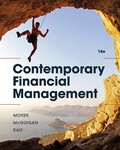
EBK CONTEMPORARY FINANCIAL MANAGEMENT
14th Edition
ISBN: 9781337514835
Author: MOYER
Publisher: CENGAGE LEARNING - CONSIGNMENT
expand_more
expand_more
format_list_bulleted
Question
Chapter 13, Problem 6QTD
Summary Introduction
To discuss: The reason why company prefer internal financing to external financing according to the perking order theory.
Expert Solution & Answer
Want to see the full answer?
Check out a sample textbook solution
Students have asked these similar questions
With the growing popularity of casual surf print clothing, two recent MBA graduates decided to broaden this casual surf concept to
encompass a "surf lifestyle for the home." With limited capital, they decided to focus on surf print table and floor lamps to accent
people's homes. They projected unit sales of these lamps to be 7,600 in the first year, with growth of 5 percent each year for the next
five years. Production of these lamps will require $41,000 in net working capital to start. The net working capital will be recovered at
the end of the project. Total fixed costs are $101,000 per year, variable production costs are $25 per unit, and the units are priced at
$52 each. The equipment needed to begin production will cost $181,000. The equipment will be depreciated using the straight-line
method over a five-year life and is not expected to have a salvage value. The effective tax rate is 21 percent and the required rate of
return is 23 percent. What is the NPV of this project?
Note:…
Forest Enterprises, Incorporated, has been considering the purchase of a new manufacturing facility for $290,000. The facility is to be
fully depreciated on a straight-line basis over seven years. It is expected to have no resale value after the seven years. Operating
revenues from the facility are expected to be $125,000, in nominal terms, at the end of the first year. The revenues are expected to
increase at the inflation rate of 2 percent. Production costs at the end of the first year will be $50,000, in nominal terms, and they are
expected to increase at 3 percent per year. The real discount rate is 5 percent. The corporate tax rate is 25 percent. Calculate the NPV
of the project.
Note: Do not round intermediate calculations and round your answer to 2 decimal places, e.g., 32.16.
NPV
Help with questions
Chapter 13 Solutions
EBK CONTEMPORARY FINANCIAL MANAGEMENT
Knowledge Booster
Similar questions
- Please help with questionsarrow_forwardCreate financial forecasting years 2022, 2023, and 2024 using this balance sheet.arrow_forwardBeta Company Ltd issued 10% perpetual debt of Rs. 1,00,000. The company's tax rate is 50%. Determine the cost of capital (before tax as well as after tax) assuming the debt is issued at 10 percent premium. helparrow_forward
arrow_back_ios
SEE MORE QUESTIONS
arrow_forward_ios
Recommended textbooks for you
 EBK CONTEMPORARY FINANCIAL MANAGEMENTFinanceISBN:9781337514835Author:MOYERPublisher:CENGAGE LEARNING - CONSIGNMENT
EBK CONTEMPORARY FINANCIAL MANAGEMENTFinanceISBN:9781337514835Author:MOYERPublisher:CENGAGE LEARNING - CONSIGNMENT Cornerstones of Cost Management (Cornerstones Ser...AccountingISBN:9781305970663Author:Don R. Hansen, Maryanne M. MowenPublisher:Cengage Learning
Cornerstones of Cost Management (Cornerstones Ser...AccountingISBN:9781305970663Author:Don R. Hansen, Maryanne M. MowenPublisher:Cengage Learning

EBK CONTEMPORARY FINANCIAL MANAGEMENT
Finance
ISBN:9781337514835
Author:MOYER
Publisher:CENGAGE LEARNING - CONSIGNMENT


Cornerstones of Cost Management (Cornerstones Ser...
Accounting
ISBN:9781305970663
Author:Don R. Hansen, Maryanne M. Mowen
Publisher:Cengage Learning

